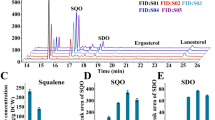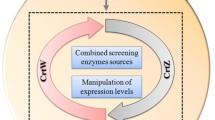Abstract
In this study, the synergistic effect of overexpressing the 3-hydroxy-3-methylglutaryl coenzyme A (HMG-CoA) reductase gene and adding ergosterol synthesis inhibitor, ketoconazole, on β-carotene production in the recombinant Saccharomyces cerevisiae was investigated. The results showed that the over-expression of HMG-CoA reductase gene and adding 100 mg/l ketoconazole alone can result in 135.1 and 15.6% increment of β-carotene concentration compared with that of the control (2.05 mg/g dry weight of cells), respectively. However, the combination of overexpressing HMG-CoA reductase gene and adding ketoconazole can achieve a 206.8% increment of pigment content (6.29 mg/g dry weight of cells) compared with that of the control. Due to the fact that over-expression of the HMG-CoA reductase gene can simultaneously improve the flux of the sterol and carotenoid biosynthetic pathway, it can be concluded that under the circumstances of blocking sterol biosynthesis, increasing the activity of HMG-CoA reductase can result in more precursors FPP fluxing into carotenoid branch and obtain a high increment of β-carotene production. The results of this study collectively suggest that the combination of overexpressing HMG-CoA reductase gene and supplying ergosterol synthesis inhibitor is an effective strategy to improve the production of desirable isoprenoid compounds such as carotenoids.




Similar content being viewed by others
References
Borgers M, Van den Bossche H, De Brabander M (1983) The mechanism of action of the new antimycotic ketoconazole. Am J Med 74:2–8
Britton G (1983) The biochemistry of natural pigments, vol 2. Cambridge University Press, London
Burke D, Dawson D, Stearns T (2000) Methods in yeast genetics. Cold Spring Harbor Laboratory Press, Cold Spring Harbor
Choi JH, Ryu YW, Park YC et al (2009) Synergistic effects of chromosomal ispB deletion and dxs overexpression on coenzyme Q10 production in recombinant Escherichia coli expressing Agrobacterium tumefaciens dps gene. J Biotechnol 144:64–69
Francis K, Danuta P, Sophie M et al (2004) Farnesyl diphosphate synthase activity affects ergosterol level and proliferation of yeast Saccharomyces cerevisae. Cell Biol Int 28:193–197
Goodwin TW (1992) Distribution of carotenoids. Methods Enzymol 213:167–172
Kim SW, Sco WT, Park YH (1997) Enhanced synthesis of trisporic acids and β-carotene production in Blakeslea trispora by addition of non-ionic surfactant, Span 20. J Ferment Bioeng 84:330–332
Kim SW, Kim JB, Ryu JM et al (2009) High-level production of lycopene in metabolically engineered E. coli. Process Biochem 44:899–905
Lees ND, Bard M, Kirsch DR (1999) Biochemistry and molecular biology of sterol synthesis in Saccharomyces cerevisiae. Crit Rev Biochem Mol Biol 34:33–47
Lee PC, Schmidt DC (2002) Metabolic engineering towards biotechnological production of carotenoids in microorganisms. Appl Microbiol Biotechnol 60:1–11
Miao LL, Chi S, Tang YC et al (2011) Astaxanthin biosynthesis is enhanced by high carotenogenic gene expression and decrease of fattyacids and ergosterol in a Phaffia rhodozyma mutant strain. FEMS Yeast Res 11:192–201
Misawa N, Shimada H (1998) Metabolic engineering for the production of carotenoids in non-carotenogenic bacteria and yeasts. J Biotech 59:169–181
Pitera DJ, Paddon CJ, Newman JD et al (2007) Balancing a heterologous mevalonate pathway for improved isoprenoid production in Escherichia coli. Metab Eng 9:193–207
Polakowski T, Stahl U, Lang C (1998) Overexpression of a cytosolic hydroxymethylglutaryl-CoA reductase leads to squalene accumulation in yeast. Appl Microbiol Biotechnol 49:66–71
Silva C, Cabral JMS, Keulen F (2004) Isolation of a β-carotene over-producing soil bacterium, Sphingomonas sp. Biotechnol Lett 26:257–262
Shimada HK, Kondo PD, Fraser Y et al (1998) Increased carotenoid production by the food yeast Candida utilis through metabolic engineering of the isoprenoid pathway. Appl Environ Microbiol 64:2676–2680
Sun Y, Yan QP, Vriesekoop F (2007) Effect of two ergosterol biosynthesis inhibitors on lycopene production by Blakeslea trispora. Process Biochem 42:1460–1464
Verduyn C, Postma E, Scheffers WA et al (1992) Effect of benzoic acid on metabolic fluxes in yeast: a continuous-culture study on the regulation of respiration and alcoholic fermentation. Yeast 8:501–517
Verwaal R, Wang J, Meijnen JP et al (2007) High-level production of beta-carotene in Saccharomyces cerevisiae by successive transformation with carotenogenic genes from Xanthophyllomyces dendrorhous. Appl Environ Microbiol 73:4342–4350
Wang GY, Keasling JD (2002) Amplification of HMG-CoA reductase production enhances carotenoid accumulation in Neurospora crassa. Metab Eng 4:193–201
Yan GL, Liang HY, Wang ZQ et al (2011) Important role of catalase in the production of β-carotene by recombinant Saccharomyces cerevisiae under H2O2 stress. Curr Microbiol 62:1056–1061
Yoon SH, Lee SH, Das A et al (2009) Combinatorial expression of bacterial whole mevalonate pathway for the production of β-carotene in E. coli. J Biotech 140:218–226
Acknowledgments
This research was supported by National Natural Science Foundation of China (No 31000811/C200207) and the Scientific Research Foundation for the Returned Overseas Chinese Scholars, State Education Ministry (20101561). We also thank Dr Rene Verwaal in Netherlands for kindly providing the vector YIplac211YB/I/E* and YIplac204 tHMG1 used in the experiment.
Author information
Authors and Affiliations
Corresponding author
Rights and permissions
About this article
Cite this article
Yan, Gl., Wen, Kr. & Duan, Cq. Enhancement of β-Carotene Production by Over-Expression of HMG-CoA Reductase Coupled with Addition of Ergosterol Biosynthesis Inhibitors in Recombinant Saccharomyces cerevisiae . Curr Microbiol 64, 159–163 (2012). https://doi.org/10.1007/s00284-011-0044-9
Received:
Accepted:
Published:
Issue Date:
DOI: https://doi.org/10.1007/s00284-011-0044-9




